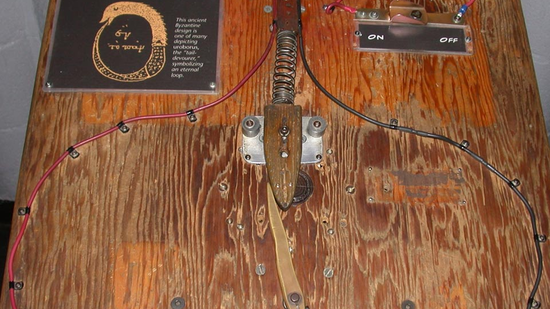Remembering Norman Tuck
Sad news arrived last week that kinetic artist and exhibit builder Norman Tuck had passed away peacefully at home. Norman contributed greatly to the collection of exhibits at the Exploratorium in San Francisco and to me, he was always a conduit to the spirit of the original museum at the Palace of Fine Arts. There are a half dozen of his creations like oscylinderscope, three balls on a string and lariat chain, that you can find in science museums all around the world.
Norman had a strong connection to our work in the Tinkering Studio and I felt lucky to have had the chance to interact and learn from him every so often in our backstage workshop.
Our team resonated with the way that Norman approached exhibit building,[ as wrote on his website, “each [piece] is product of exploration and experimentation. I’m “old-school” and do all the work myself, largely because I like the feel of tools and materials. I’ll notice some phenomenon that strikes my interest, and I start fooling around with stuff to explore what I had found interesting.”
I feel that Norman’s exhibits have a quality of poetry, expressing a clear perspective and point of view but leaving things open enough where each person can bring their own ideas to the experience. The type of soulful interaction doesn’t have the goal of merely conveying information but instead involves visitors in an immersive mini-worlds and allows them to make their own discoveries. As Axel Hüttinger asks in his article, What is Innovative Exhibition Design?, “[do good exhibitions] touch the visitors if or because it is the place where they encounter the original?” I think that’s a key component in Norman’s work, that there is something undeniably ‘original’ about the creations.
Some of the qualities that contribute to the brilliance of Norman Tuck’s exhibits include the use of everyday materials in surprising and unusual ways (see the guitar in oscylinderscope or the bike wheel and chain in lariat chain). The exhibits have a handmade quality that belies a deeper craftsmanship. And they are clearly are the result of prototyping with physical materials, iteration and close observation.
I love this series of rougher prototypes as well that use everyday materials to show simple phenomena like electrical impulses or magnetism. These exemplify the quote from Frank Oppenheimer that the Exploratorium, “didn’t want anything in the museum to convey the message ‘Isn’t somebody else clever.’” but instead had the goal to build stations where people could feel clever themselves. This is the sort of subtle and extremely difficult-to-pull-off approach that Norman Tuck excelled at in so many of his machines.
One of the exhibits that follow this direction currently on the floor of the Exploratorium is the Uroboros, a delightful, whimsical switching motor with a rough-hewn and transparent quality. As an explainer, I spent many hours trying to understand the connections and later as a designer of activities, I’ve taken a lot of inspiration from the mix of sturdy, homemade and whimsical properties of the exhibit.
One of my favorite (albeit half-baked) ideas that the Tinkering Studio explored in our prototyping workshop at the PFA was a history of one of Norman’s classic exhibits, osylinderscope. It was really fun to display the prototype for the exhibit, the finished design and a new remix by Nicole Catrett inspired by the idea. When we opened our new Tinkering gallery at Pier 15 we chose many of Norman’s creations as entry points to the space to give visitors a first taste of the tinkering spirit.
While designing our new Tinkering Studio space at Pier 15, we asked Norman to create a new welcome exhibit at the gate of the workshop, Your Turn Counts seems simple enough with a series of numerical displays showing the progression of counter technology, but the ultimate interaction offers lots of deeper meaning.
The fact that each turn “counts” makes a strong statement that the tinkering process can only work with the input and contributions of each visitor. As well each time the counter “turns over” to the next big display, a small crowd gather, cheer and sometimes film the interaction, reinforcing the community aspect of the studio.
Norman touched a lot of people with his presence and his exhibits have connected with so many science center visitors of all ages all around the world. To conclude my tribute, here’s a video from his website that shows him speaking about many of his creations which can give a sense of the person and the indelible mark he made on the field. Take a look and enjoy the roll call of delightful exhibits and the thoughts of this fascinating human who constructed so many wonderfully poetic machines.





